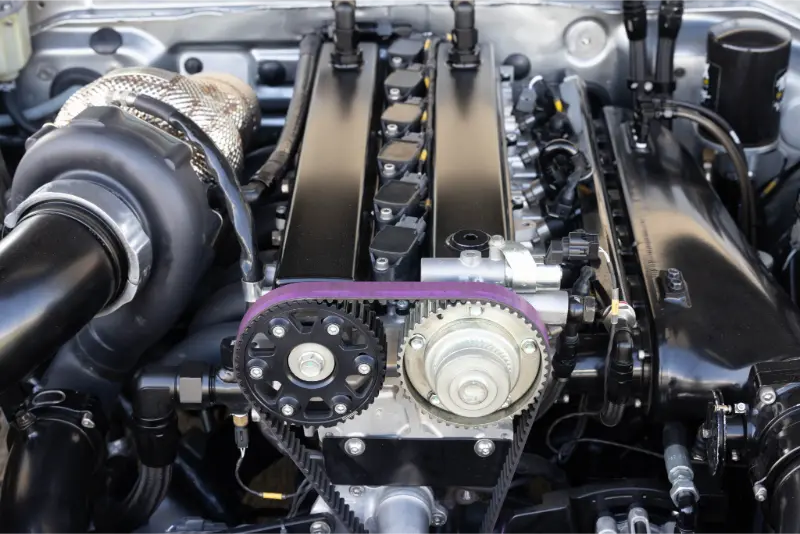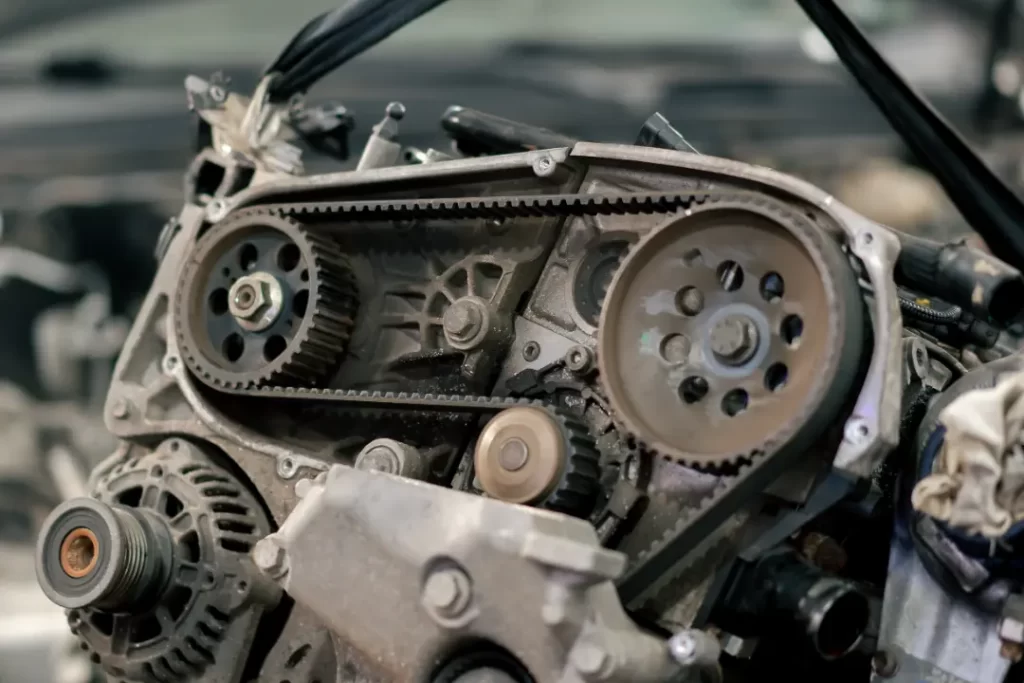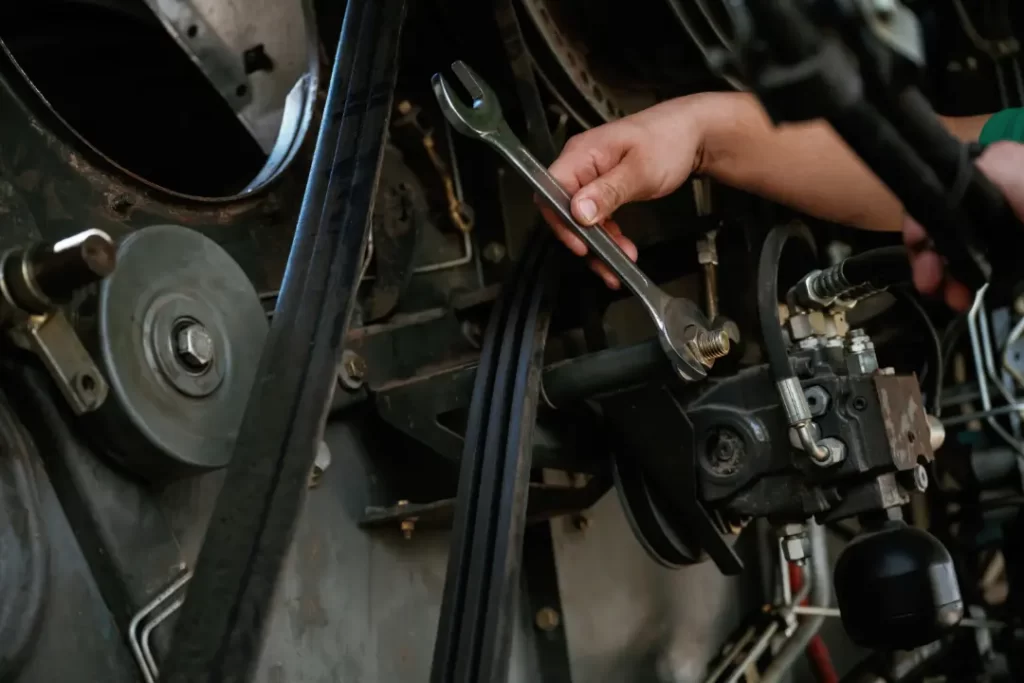How often should you replace your cam belt? The simple answer is every 60,000 to 100,000 miles or every 5 to 7 years, whichever comes first. This vital component is essential for the smooth running of your engine, and neglecting its replacement schedule can lead to severe engine damage and cam belt failure.
This article will help you understand what a cam belt is, how to know when it needs replacing, and the consequences of ignoring its maintenance.
Key Takeaways
- It is essential to have the cambelt replaced, also known as the timing belt, every 60,000 to 100,000 miles or every 5 to 7 years, as per the manufacturer’s recommendations, to ensure the engine’s smooth operation.
- Signs that a cam belt needs replacement include unusual noises, difficulty starting the car, and visible wear and tear, such as fraying and cracking, which should be addressed promptly to avoid severe engine damage.
- Preventative maintenance practices, like regular inspections for oil contamination and adherence to replacement schedules, are crucial for extending the life of the cam belt and ensuring vehicle safety and performance.

What is a Cam Belt?
A cam belt, also known as a timing belt or auxiliary belt, is an essential component in a car’s engine. It’s a robust rubber belt, often reinforced with materials like Kevlar and polyurethane, that features teeth on its inner side. These teeth grip onto the camshaft and crankshaft gear, synchronising their rotation and ensuring the engine’s valves open and close in perfect harmony with the movement of the pistons.
This synchronisation is crucial for the engine’s smooth operation, and the cam belt’s role is pivotal in maintaining the timing and rhythm of the engine’s internal processes. The engine’s performance can be severely compromised without a properly functioning cam belt, leading to potential damage.
Recommended Replacement Intervals
A timing belt doesn’t last forever and needs regular checks and replacement. Following the manufacturer’s recommendations is crucial to keeping your vehicle’s engine in good shape. Normally, you should replace the timing belt every 60,000 to 100,000 miles or every 5 to 7 years, whichever comes first. However, this can vary for different vehicles.
Ignoring these guidelines can be risky. Relying the timing belt on time is important to avoid expensive and dangerous consequences. Regular replacement ensures safe travel and keeps your car’s internal combustion engine functioning well.
Signs Your Cam Belt Needs Replacing
The cambelt may display several signs indicating the need for immediate attention. Unusual noises, difficulty starting the engine, and visible wear and tear are signs that the cambelt needs replacement to maintain the engine’s timing.
Unusual Noises
There are several sounds that can indicate a problem with your cambelt. A high-pitched squealing noise may mean the rubber belt slipping on the metal pulley. If the belt is about to fail, you might hear a repetitive ticking or clicking, which shows that the engine components are no longer in sync. If you hear these unusual noises, don’t ignore them. Pull over and consult a professional immediately.
These sounds are clear signs that your cambelt needs immediate attention. Ignoring them can lead to a catastrophic failure of the cambelt, something no car owner wants to experience.
Difficulty Starting the Car
Having trouble starting the car? When you turn the key, and the engine hesitates, it can be alarming. This issue can often be caused by a worn cam belt that has lost its grip, preventing the camshaft from turning as it should.
The precise timing of the engine’s components is crucial for its smooth operation, and a worn cam belt can disrupt this, leading to difficulty starting the engine. If you find that it’s becoming harder to start your engine, it could be a sign that the worn cam belt needs attention to maintain proper engine timing.
Visible Wear and Tear
The condition of the cambelt can often be easily assessed, as signs of wear and tear such as fraying edges and cracks may be visible. A shiny or glazed appearance on the underside of the belt is an indication that the rubber has become hardened and lost its elasticity.
Regular inspections are essential for preventing damage to the cambelt caused by ageing. By carefully examining this important part, you can detect signs of wear and tear before they escalate into serious damage. This proactive approach is crucial for preserving your vehicle’s performance and ensuring its roadworthiness.
Consequences of a Broken Cambelt
The failure of a cambelt can cause significant damage to your engine. When the cambelt breaks, it can lead to engine valves and pistons colliding with destructive force, potentially resulting in serious damage. Ignoring the signs of a worn cambelt, such as unusual noises, reduced power, or engine smoke, can lead to catastrophic failure.
If the belt breaks while the engine is running, it can seize, posing a danger to your safety as it could result in a loss of control over steering and brakes. Therefore, regular cambelt maintenance is essential to prevent expensive and severe engine damage.

Differences Between Timing Belts and Timing Chains
The timing belt and the cam chain play crucial roles in engine performance, but they differ in material and operation. The timing belt is made of rubber, which makes it quiet and cost-effective, while the cam chain is made of metal and needs lubrication to keep the engine running smoothly. Each component has its own specific characteristics and benefits.
Cam chains have a longer lifespan due to their durable metal links, but they can be more expensive to replace. On the other hand, timing belts may need to be replaced more frequently, but they are quieter and more affordable. Both cam chains and timing belts require proper maintenance to ensure the engine performs optimally.
Cost of Cam Belt Replacement
Replacing a cam belt can be a significant investment, but it’s crucial for maintaining the health of your vehicle’s internal combustion engine. The cost of a new cam belt typically ranges from £200 to £600, depending on the make and model of your vehicle. Labor costs can add another £200 to £500, bringing the total to anywhere between £400 and £1,100. For luxury vehicles, the cost can be even higher.
While these figures might seem steep, consider the alternative: neglecting to replace a worn-out cam belt can lead to serious engine damage. If the cam belt fails, it can cause the engine’s valves and pistons to collide, resulting in costly repairs that far exceed the price of a timely cam belt replacement. Investing in a new cam belt is a proactive measure that ensures the longevity and performance of your vehicle’s internal combustion engine.
Alternatives to Cam Belts
While cam belts are widely used in vehicle’s internal combustion engines, there are alternatives like timing chains, also known as cam chains. Timing chains are made of metal, which makes them more durable and less prone to wear and tear compared to rubber cam belts. This durability often translates to a longer lifespan, making timing chains a popular choice for some vehicle manufacturers.
However, timing chains come with their own set of challenges. They can be noisier than cam belts and may require more frequent maintenance to keep them running smoothly. Additionally, the cost of replacing a timing chain can be higher than that of a cam belt, especially if the replacement is not done at the recommended interval. Despite these drawbacks, the longevity and durability of timing chains make them a viable alternative for many vehicles.
Cam Belt Preventative Maintenance Tips
Regular maintenance is essential for a well-functioning engine, ensuring that each component works together seamlessly in your vehicle’s internal combustion engines. Regularly checking for oil contamination on the cambelt can prevent the rubber from degrading prematurely, thereby maintaining its integrity and performance. As the cambelt ages, it may dry out and crack, especially in colder climates where winter’s chill can make it brittle.
Embracing the practice of preventative maintenance helps safeguard against unexpected breakdowns. Regular vehicle check-ups, following the manufacturer’s recommendations found in your vehicle handbook, and being attuned to signs of wear are your tools for maintaining a smooth-running engine. By being proactive, you not only extend the life of your cambelt but also ensure the safety and reliability of your treasured vehicle.

DIY Replacement vs Professional Mechanic
While the idea of replacing your cam belt yourself might be tempting, it’s generally best to leave this task to a professional mechanic. Replacing a cam belt is a complex job that requires specialized tools and a deep understanding of your vehicle’s engine. If done incorrectly, it can lead to serious engine damage, resulting in costly repairs and potential safety risks.
A professional mechanic has the expertise and experience to replace your cam belt correctly, ensuring that your vehicle’s engine runs smoothly and efficiently. They can also inspect the engine for any other potential issues that might arise during the replacement process. Attempting a DIY cam belt replacement without the necessary skills and tools can lead to a range of problems, including engine damage and increased repair costs. For peace of mind and the health of your vehicle, it’s best to trust a professional mechanic with this critical task.
Choose Ivydene Garage Ltd. for Expert Cam Belt Replacement
Choose Ivydene Garage Ltd. for expert cam belt replacement. With over 32 years of expertise, Ivydene Garage offers reliable and durable automotive care services. As a family-owned business in Ashford, Kent, we combine technical expertise with cutting-edge diagnostic equipment to ensure that each vehicle is serviced with precision and care.
Established in 1981, Ivydene Garage Ltd. is a team of passionate experts dedicated to the art of car maintenance. Our technicians use only Original Equipment Manufacturer (OEM) cambelts and perform each cambelt replacement with meticulous attention to detail. We service a wide range of vehicles and possess the latest diagnostic tools to identify and rectify any issues within your engine.
If you need a trusted cambelt replacement in Ashford, look no further than Ivydene Garage. Our team of experts is ready to assist you with all your cambelt needs, from selecting the right cambelt for your car to perfect fitting. We’ll ensure that your car is running like new in no time. Contact us today to get started.
Frequently Asked Questions
How do I know when it’s time to replace my cambelt?
To determine when to replace your cambelt, refer to your vehicle’s owner’s manual or consult a professional mechanic for specific recommendations. The general timing for replacement is every 60,000 to 100,000 miles or every 5-7 years.
What are the risks of not replacing my cambelt on time?
Delaying cambelt replacement can lead to serious engine damage, including costly valve-piston collisions. To avoid these issues, it’s crucial to follow the recommended replacement intervals.
Can I replace my cambelt myself?
It’s recommended to have a professional mechanic perform the cambelt replacement, as it is a complex task that requires special tools and expertise.
What’s the difference between a timing belt and a timing chain?
The primary difference between a timing belt and a timing chain is that the timing belt is made of rubber and needs replacement more often, while the timing chain is made of metal and has a longer lifespan. Timing chains also require lubrication for smooth operation.
Is it more cost-effective to replace the water pump when changing the cambelt?
Yes, replacing the water pump when changing the cambelt is more cost-effective because it can save on labour costs and prevent future issues.
Final Thoughts
Always remember the importance of regular maintenance and the expertise of experienced professionals. The cam belt plays a crucial role in your vehicle’s engine and requires timely care to keep your journeys trouble-free. Ivydene Garage Ltd. is a trusted establishment known for its expertise and reliability.
By entrusting your cambelt care to our capable hands, you are ensuring smooth drives and harmonious adventures in the future. Keep in mind that a well-maintained cam belt is essential for the longevity and performance of your beloved automobile.
